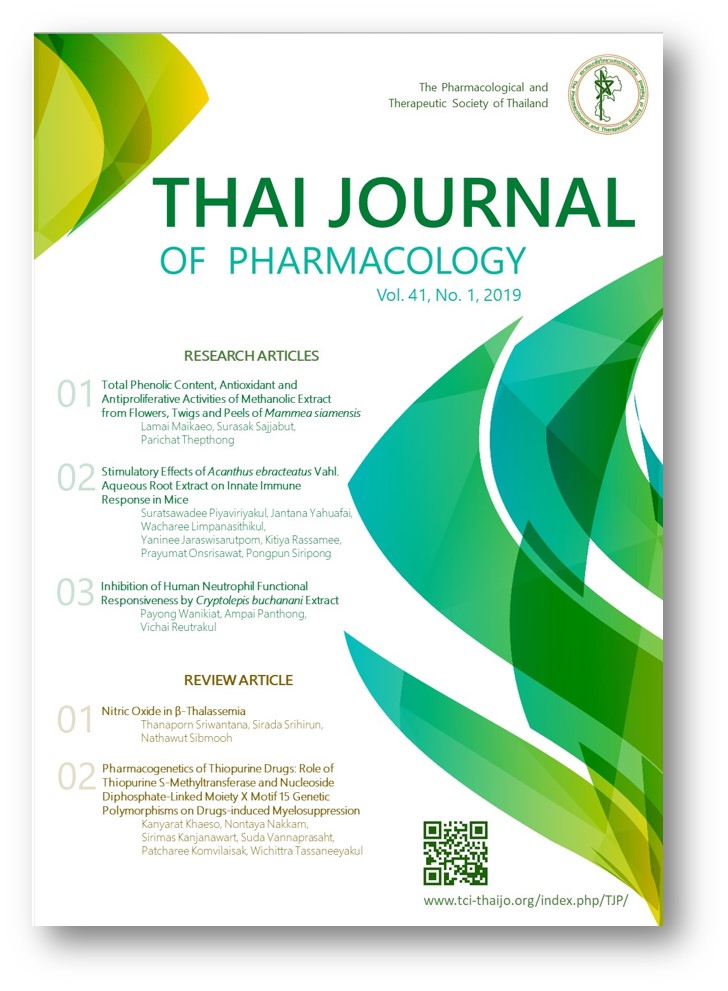Total Phenolic Content, Antioxidant and Antiproliferative Activities of Methanolic Extract from Flowers, Twigs and Peels of Mammea siamensis
Main Article Content
Abstract
Liver cancer remains the first leading cause of cancer death in Thai patients. Nowadays, cancer chemotherapy and radiation therapy often cause side effects. The use of natural products may be an alternative for alleviating these side effects. Plants are potential sources of natural products exhibiting antioxidant and antiproliferative effects against cancer cells. Mammea siamensis (or Saraphi) is a Thai medicinal herb rich in coumarins and xanthones, which has been demonstrated to possess anticancer properties in many cancer cell lines. The aims of this study were to evaluate total phenolic content, antioxidant and antiproliferative activities of the methanolic extracts from flowers, twigs and peels of M. siamensis. The results showed that 2,2-diphenyl-1-picrylhydrazyl (DPPH) radical scavenging capacities of the extracts from flowers, twigs and peels of M. siamensis were 21.77±0.21, 19.2±0.21, and 10.65±0.3 mg ascorbic acid equivalent (AAE)/g, which were correlated with their total phenolic contents (43.34±0.51, 43.11±1.01, and 29.22±0.83 mg gallic acid equivalent (GAE)/ g). Moreover, the methanolic extracts from flowers and twigs exhibited greater antiproliferative activity against hepatocellular carcinoma (HepG2) cells than that from peels, as shown by the IC50 values of 26.97±3.62, 27.99±1.04, and 187.19±4.71 µg/mL, respectively. This study concluded that there was a correlation between antioxidant activity and total phenolic content in the extracts. The methanolic extracts from flower and twigs of M. siamensis also possessed antiproliferative activity against HepG2 cells. The bioactive compounds from the active parts of M. siamensis should be identified in further studies.
Article Details
Upon acceptance of an article, the Pharmacological and Therapeutic Society of Thailand will have exclusive right to publish and distribute the article in all forms and media and grant rights to others. Authors have rights to use and share their own published articles.
References
2. Boutennoun H, Boussouf L, Rawashdeh A, Al-Qaoud K, Abdelhafez S, Kebieche M, et al. In vitro cytotoxic and antioxidant activities of phenolic components of Algerian Achillea odorata leaves. Arab J Chem. 2017 Mar;10(3):403-9.
3. Qader SW, Abdulla MA, Chua LS, Najim N, Zain MM, Hamdan S. Antioxidant, total phenolic content and cytotoxicity evaluation of selected Malaysian plants. Molecules. 2011 Apr 21;16(4):3433-43.
4. Treasure J. Herbal medicine and cancer: an introductory overview. Semin Oncol Nurs. 2005 Aug;21(3):177–83.
5. Strategy and Planning Division, Bureau of Policy and Strategy. Public Health Statistics A.D.2017. Nonthaburi: Ministry of Public Health; 2018. 146 p.
6. Srivatanakul P. Epidemiology of liver cancer in Thailand. Asian Pac J Cancer Prev. 2001;2(2):117-21.
7. Gomaa AI, Khan SA, Toledano MB, Waked I, Taylor-Robinson SD. Hepato-cellular carcinoma: epidemiology, risk factors and pathogenesis. World J Gastroenterol. 2008 Jul 21;14(27):4300-8.
8. Kirstein MM, Vogel A. Epidemiology and risk factors of cholangiocarcinoma. Visc Med. 2016 Dec;32(6):395-400.
9. Le Grazie M, Biagini MR, Tarocchi M, Polvani S, Galli A. Chemotherapy for hepatocellular carcinoma: The present and the future. World J Hepatol. 2017 Jul 28;9(21):907-20.
10. Lee IJ, Seong J. Radiotherapeutic strategies in the management of hepatocellular carcinoma. Oncology. 2011;81 Suppl 1:123-33.
11. Song KD. Percutaneous cryoablation for hepatocellular carcinoma. Clin Mol Hepatol. 2016 Dec;22(4):509-15.
12. Van Ha TG. Transarterial chemoembolization for hepatocellular carcinoma. Semin Intervent Radiol. 2009 Sep;26(3):270–5.
13. Tung NH, Uto T, Sakamoto A, Hayashida Y, Hidaka Y, Morinaga O, et al. Antiproliferative and apoptotic effects of compounds from the flower of Mammea siamensis (Miq.) T. Anders. on human cancer cell lines. Bioorg Med Chem Lett. 2013;23(1):158-62.
14. Mahidol C, Kaweetripob W, Prawat H, Ruchirawat S. Mammea coumarins from the flowers of Mammea siamensis. J Nat Prod. 2002 May;65(5):757-60.
15. Laphookhieo S, Promnart P, Syers JK, Kanjana-Opas A, Ponglimanont C, Karalai C. Coumarins and xanthones from the seeds of Mammea siamensis. J Braz Chem Soc. 2007;1077-80.
16. Poobrasert O, Constant HL, Beecher CWW, Farnsworth NR, Kinghorn AD, Pezzuto JM, et al. Xanthones from the twigs of Mammea siamensis. Phytochemistry. 1998 Apr;47(8):1661-3.
17. Ngo NT, Nguyen VT, Vo HV, Vang O, Duus F, Ho TD, et al. Cytotoxic coumarins from the bark of Mammea siamensis. Chem Pharm Bull (Tokyo). 2010 Nov;58(11):1487-91.
18. Mahavorasirikul W, Viyanant V, Chaijaroenkul W, Itharat A, Na-Bangchang K. Cytotoxic activity of Thai medicinal plants against human cholangiocarcinoma, laryngeal and hepatocarcinoma cells in vitro. BMC Complement Altern Med. 2010 Sep;10:55.
19. Rungrojsakul M, Saiai A, Ampasavate C, Anuchapreeda S, Okonogi S. Inhibitory effect of mammea E/BB from Mammea siamensis seed extract on Wilms’ tumour 1 protein expression in a K562 leukaemic cell line. Nat Prod Res. 2016; 30(4):443-7.
20. Velioglu YS, Mazza G, Gao L, Oomah BD. Antioxidant activity and total phenolics in selected fruits, vegetables, and grain products. J Agric Food Chem. 1998 Oct 1;46(10):4113-7.
21. Khattak KF, Simpson TJ, Ihasnullah. Effect of gamma irradiation on the extraction yield, total phenolic content and free radical-scavenging activity of Nigella staiva seed. Food Chem. 2008 Oct;110(4):967-72.
22. Suffness M, Pezzuto JM. Assays related to cancer drug discovery. In: Hostettmann K, editor. Methods in plant biochemistry: Assays for bioactivity. London: Academic Press; 1990. p. 71-133.
23. Danciu C, Vlaia L, Fetea F, Hancianu M, Coricovac DE, Ciurlea SA, et al. Evaluation of phenolic profile, antioxidant and anticancer potential of two main representants of Zingiberaceae family against B164A5 murine melanoma cells. Biol Res. 2015 Jan 12;48(1):1.


